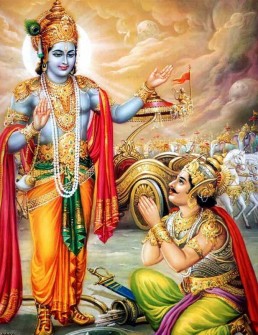The term ‘death’mentioned here does not mean only the irrevocable physical death, but also the “death of the ego,” which is to be brought about through the steady practice of meditation. This stanza is added to the discourse to show that after the sublimation of the limited ego, one can live in full Godly Awareness as a liberated God-man, even here, while living this very life!
One who is practising the above method of living in the world, “AS A SOJOURNER THEREIN, AND NOT AS A NATIVE OF IT,” and who is training the mind constantly to rest upon the contemplation of the Self, becomes single-pointed in his concentration. This, in fact, is a revolutionary interpretation of the techniques of prayer and concentration (Upasana) as explained in the Vedas and also the methods of devotion and surrender championed in the Puranas, while what is advised in the preceding stanza is religion lived in the market-place, the everyday-Samnyasa for the man of action, in the very fields of his own activities.
By this practice the devotee develops single-pointedness of the mind which helps to integrate his intellect. With such well-tuned up and nobly adjusted instruments of perception and comprehension, and intuitive realisation of the Divine, the Self becomes an easy experience: “DWELLING ON THE SUPREME, RESPLENDENT PURUSHA, O SON OF PRITHA, ONE GOES TO HIM.” With integrated mind, whatever the individual meditates upon intensively, he must come to gain it soon enough. Thus, the stanza indicates an ampler significance than what has been so far declared. This realisation of the Self, and thereby gaining one’s identity with It, can actually take place in this very same life, if, with prepared mind and intellect one can, with steadfastness, meditate upon Me, “THE SUPREME RESPLENDENT PURUSHA.
The term that has been used to indicate the one who meditates upon the Self (Anuchintayan) is very significant. Thoughts of the same species, made to run towards one fixed ideal or goal, in an unbroken flow, are called “meditations.” The prefix ‘Anu’ in ‘Anuchintayan’ provides this significant meaning of the “continuity” of the flow-of-thought, in one determined channel of contemplation.
WHAT ARE THE SPECIFIC QUALITIES OF THIS GREAT PURUSHA UPON WHOM WE ARE CONSTANTLY TO MEDITATE?

